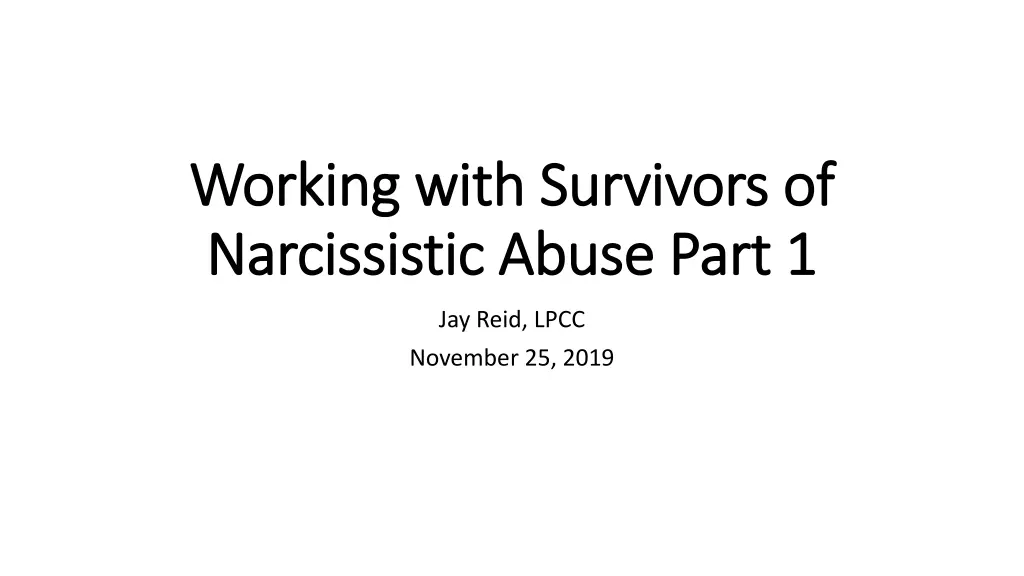
Understanding Narcissistic Abuse and Trauma in Family Systems
Explore the dynamics of narcissistic abuse within family systems, examining the roles of the Narcissistic Parent, Enabler Parent, Scapegoated Child, Golden Child, and Lost Child. Learn about the varying degrees of narcissism, key traumas experienced by children of narcissists, and effective therapeutic interventions for survivors.
Download Presentation

Please find below an Image/Link to download the presentation.
The content on the website is provided AS IS for your information and personal use only. It may not be sold, licensed, or shared on other websites without obtaining consent from the author. If you encounter any issues during the download, it is possible that the publisher has removed the file from their server.
You are allowed to download the files provided on this website for personal or commercial use, subject to the condition that they are used lawfully. All files are the property of their respective owners.
The content on the website is provided AS IS for your information and personal use only. It may not be sold, licensed, or shared on other websites without obtaining consent from the author.
E N D
Presentation Transcript
Working with Survivors of Working with Survivors of Narcissistic Abuse Part 1 Narcissistic Abuse Part 1 Jay Reid, LPCC November 25, 2019
Outline The narcissistically abusive family system Key traumas resulting from a narcissistically abusive family system Undeservedness and accommodation in resulting pathogenic beliefs Helpful therapeutic interventions/attitudes with survivors Case Formulation
= Most likely to show up in therapy as adults The narcissistic family system Narcissistic Parent (NP): Self-absorbed, Believe their needs are more important than others Fragile self-esteem Must feel superior at all times Little/No empathy Sometimes motivated by cruelty Enabler Parent (EP): Weak-willed Afraid of confrontation Seeks harmony at all times Dissociative Secretive Critical Scapegoated Child (SC): Source of shame for NP (b/c of what SC reflects back to the NP NOT who the SC is) Prone to protest injustice Likely to see and name the NP s abusive tactics Psychologically strongest family member Golden Child (GC): Source of pride for NP Coerced to feel loyal to NP Coerced to collude against SC Can develop similar traits as NP Lost Child (LC): Seeks to avoid being noticed by NP or EP Private & secretive May over-caretake others Can develop similar traits to EP
Severity of narcissism in the NP NP s can vary in how destructive they are Some are mostly aloof and rely on implicit communication to enforce their perceived entitlements The coercive pressure they exert is a means to the end of being exulted Others actively attack and undermine others to feel superior (i.e. malignant narcissists) The coercive pressure is an end in itself - cruelty feels good to them Assessing how much psychological aggression was present in the NP is important in working with survivors
Key Traumas for children of narcissists NP s needs, opinions, plans, and/or desires had to be regarded as most important or else NP could withdraw love, attack, and/or collude against A lie has to be believed that the NP is irreproachable and superior in all ways Sometimes the truth that the NP is not perfect must be remembered to be forgotten time and again The NP can treat the child like they are undeserving of any emotional nourishment The EP can treat the child like they are undeserving of protection from abuse
Common Pathogenic Beliefs for LCs & SCs I am physically disgusting. If I am not being productive, I am worthless. I am always one mistake away from complete ruin. I am defective. I have no skills or talents. If I disagree, I will be hated and exiled. From: https://jreidtherapy.com/scapegoated-by-narcissistic-parent/
Therapeutic attitudes that help correct co- narcissistic pathogenic beliefs Children of narcissists have all experienced a vacuum in response to their inner worlds. Nature abhors a vacuum. So the void often gets filled with negative self- evaluations. Therapeutic attitudes and interventions must countervail this warchest of negativity towards the self The client s actual reception in and outside the therapy room can be registered and remarked upon when appropriate to counter narratives of self-deficiency Emphatically and iteratively highlighting the pathology of the NP and EP And the arrangement of therapy itself is pro-plan to the child of narcissists: receiving someone else s genuine attention, curiosity and support for their internal world.


